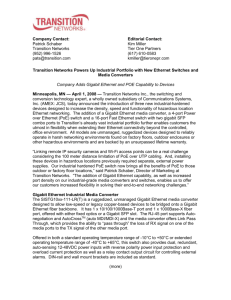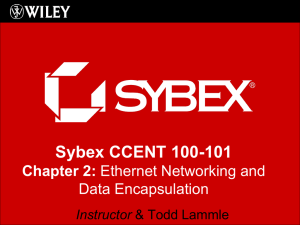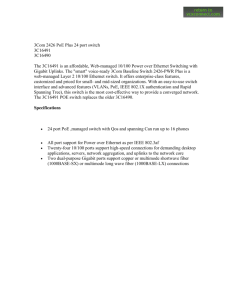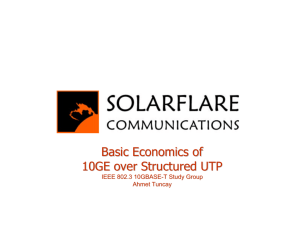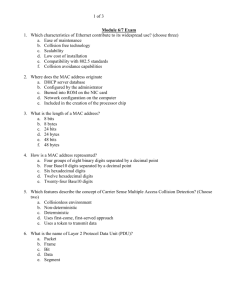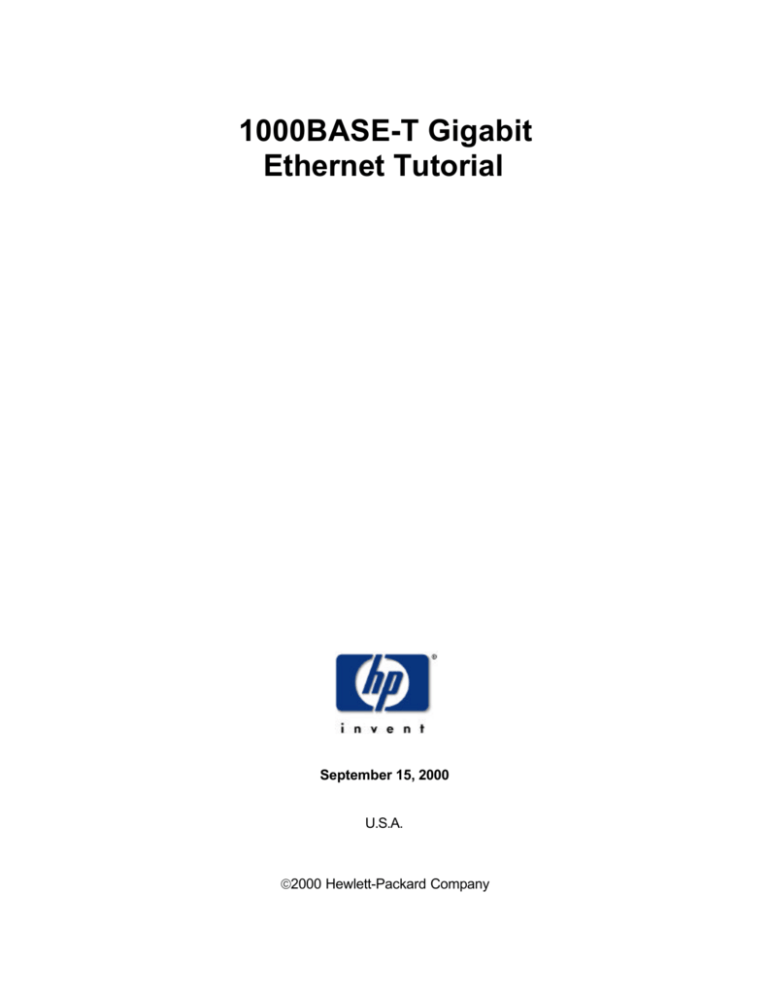
1000BASE-T Gigabit
Ethernet Tutorial
September 15, 2000
U.S.A.
2000 Hewlett-Packard Company
Legal Notices
The information in this document is subject to change without notice.
Hewlett-Packard makes no warranty of any kind with regard to this white paper, including but not
limited to the implied warranties of merchantability and fitness for a particular purpose. HewlettPackard shall not be held liable for errors contained herein or direct, indirect, special, incidental or
consequential damages in connection with the furnishing, performance, or use of this material.
Copyright Notices. ©copyright 2000 Hewlett-Packard Company, all rights reserved.
Reproduction, adaptation, or translation of this document without prior written permission is
prohibited, except as allowed under the copyright laws.
Trademark Notices. UNIX is a registered trademark of the Open Group.
1000BASE-T Gigabit Ethernet Tutorial
Introduction
1000BASE-T provides the greatest cost advantage for reliable Gigabit Ethernet (GbE)
connectivity because it works equally well over UTP Category 5 cable (CAT5) installed after
1995 and UTP Category 5e cable (CAT5e).
This long-haul, copper-based standard is ideally suited for use within the data center because
its topology rules are identical to those of the Fast Ethernet 100BASE-TX standard.
The purpose of this tutorial is to introduce basic 1000BASE-T deployment concepts:
•
IEEE 802.3 Working Group: This workgroup was responsible for developing the
current IEEE 802.3z and IEEE 802.3ab Gigabit Ethernet standards. Both standards
are discussed.
•
1000BASE-T vs. 1000BASE-SX: HP Fiber and Copper GbE NICs are compared.
•
UTP CAT5 and CAT5e Cable: Specific cabling recommendations are presented.
•
100BASE-TX vs. 1000BASE-T: Fast Ethernet 100BASE-TX and 1000BASE-T are
compared.
•
Taking the Next Step: Specific 1000BASE-T deployment suggestions are
presented.
Gigabit Ethernet can be deployed using four different physical layers. Two of these layers use
copper cable (1000BASE-T and 1000BASE-CX) and the other two use fiber optic cable
(1000BASE-LX and 1000BASE-SX). The table below summarizes the major differences
between 1000BASE-T and the other GbE physical layer standards.
IEEE Designation
Description
Cabling
Maximum Distance
1000BASE-T
(IEEE 802.3ab)
Long Haul Copper
Physical Layer
UTP
CAT5 and CAT5e
100m
1000BASE-CX
(IEEE 802.3z)
Short Haul Copper
Physical Layer
Shielded Copper
25m
1000BASE-LX
(IEEE 802.3z)
Long Haul Fiber
Physical Layer
9 micron
Single-mode Fiber
up to 5km
1000BASE-SX
(IEEE 802.3z)
Short Haul Fiber
Physical Layer
62.5 micron
Multi-mode
Fiber or 50 micron
Multi-mode Fiber
Up to 275m
or 550m
respectively.
-- Page 1 --
The IEEE 802.3 Working Group
The IEEE 802.3 Working Group started work on the current GbE standard in 1995. The
goal of the IEEE 802.3 Working Group was to give the current Fast Ethernet base a costeffective way to upgrade their systems to GbE, while leveraging their existing investment
in hubs, switches, and routers. Consequently, two teams were formed with two very
specific missions. The results of those efforts culminated in the establishment of IEEE
802.3z standards in 1998 and IEEE 802.3ab standards in 1999.
IEEE 802.3z Summary
The IEEE 802.3z standard addresses the overall
requirements for 1000 Mbps operation, plus
three of the four physical layer interfaces using
existing Fibre Channel technology.
IEEE 802.3ab Summary
The IEEE 802.3ab standard deals with one of
the four physical layer specifications. It gives
GbE customers the ability to use existing
100BASE-TX CAT5 cabling with 1000BASE-T.
•
1000BASE-CX: (Copper-based media, short
haul) supporting distances up to 25 meters.
•
1000BASE-LX: (1300nm LWL - long
wavelength) single-mode fiber (SMF)
supporting distances up to 5km.
UTP CAT5 cable was chosen because it
represents the majority of all existing
horizontally installed UTP cable.
The designation for this physical layer interface
is 1000BASE-T. It supports distances up to 100
meters.
•
1000BASE-SX: (850nm SWL - short
wavelength) 62.5 micron or 50 micron
multimode fibre (MMF) supporting distances
up to 275 meters or 550 meters respectively.
MAC Layer
1000BASE-T implementation uses a
sophisticated Digital Signal Processing (DSP)
design to address specific challenges in
transmitting 1000 Mbps over CAT5 UTP cable.
Gigabit Ethernet Technology Family
Media Access Control (MAC)
Full Duplex / Half Duplex
Gigabit Media Independent Interface (GMII)
1000BASE-X 8b/10b
Encoder / Decoder
1000BASE-CX
Transceiver
Physical Layer
1000BASE-LX
Transceiver
1000BASE-T
Encoder / Decoder
1000BASE-SX
Transceiver
802.3z
-- Page 2 --
1000BASE-T
Transceiver
802.3ab -- UTP Category 5/ 5e
1000BASE-T Gigabit Ethernet Tutorial
1000BASE-T vs. 1000BASE-SX
There are two available options when deploying Gigabit Ethernet using HP GbE NIC
products.
Auto Negotiation
1000BASE-T (A4929A)
IEEE 802.3ab compliant NICs for the
PCI bus.
This feature automatically negotiates a
physical link with the link partner. It also
determines the speed and duplex settings.
HP PCI 1000BASE-T NICs support link
speeds of 10/100/1000 Mbps with autonegotiation. This feature automatically
detects the maximum link rate and
duplex mode supported by the remote
link partner. It also adjusts the speed
and duplex of the HP NIC to the most
optimal operating condition.
Network
1000BASE-SX (A4926A)
IEEE 802.3z compliant fiber-based NICs for the HSC and PCI buses.
The table shown below compares the two standards and discusses relevant HP product
features.
HP Product
Typical Use
1000BASE-T
Long-haul
Copper
Horizontal copper
cabling for distances
up to 100m.
HSC
PCI
Jumbo Frames
Link Modes
ü
9000 byte MTU
supported in
1000 Mbps
Full Duplex Only
•
Auto-negotiation at
10/100/1000 Mbps
Link Speeds
•
•
Half Duplex support
for 10/100 Mbps Only
Full Duplex Support
For 10/100/1000
Mbps
•
Manual Override
•
•
1000 Mbps Link
Speed
Full Duplex Only
•
Auto-negotiation
•
Manual Override
HP’s 10/100/1000
Mbps support makes
this NIC an ideal
choice for easy
migrations.
1000BASE-SX
Short-haul
Fiber
For distances up to
550m over multimode fiber.
ü
ü
Ideal for horizontal
or shorter distances
backbone
applications within a
data center.
-- Page 3 --
9000 byte MTU
supported in
1000 Mbps
Full Duplex Only
UTP CAT5 and CAT5e Cable
The 1000BASE-T GbE physical layer is designed for use on all UTP CAT5e cable. It is
also suitable for use with all CAT5 cable manufactured after 1995 in accordance with the
ANSI/TIA/EIA-568-A (1995) standard.
UTP Cable Category
1000 BASE-T Recommendations
Category 5
Installed Before 1995
UTP CAT5 cabling installed prior to 1995 is totally suitable for Fast
Ethernet 100BASE-TX. However, it may not yield consistent
performance results when used with 1000BASE-T GbE. This is because
the standard was first established in 1991 and then modified in 1995.
NOTE: If your existing CAT5 cable was installed before 1995, make sure
that it has been fully tested for use with 1000BASE-T. For the most
current test procedures and 1000BASE-T installation recommendations,
please refer to the Gigabit Ethernet Alliance web site at: www.gigabitethernet.org.
Category 5
Installed After 1995
When the IEEE first began work on the 1000BASE-T physical layer
standard, it based its specifications on the CAT5 standard 1995 update.
All cable installed after 1995 is ideally suited for use with 1000BASE-T.
Category 5e
(Enhanced)
1000BASE-T works equally well over CAT5 and CAT5e cable. The
principal difference between the two cables is that CAT5e includes
performance enhancements.
NOTE: Use your on-hand supply of CAT5 cable, produced after 1995,
with confidence. When it comes time to replenish your supply be sure to
ask for CAT5e (Enhanced) cable.
1000BASE-T Topology Rules
The topology rules for GbE 1000BASE-T and Fast Ethernet 100BASE-TX are identical.
CAT5 and CAT5e link lengths are limited to 100 meters by the ANSI/TIA/EIA-568-A
(1995) cabling standard.
-- Page 4 --
1000BASE-T Gigabit Ethernet Tutorial
100BASE-TX vs. 1000BASE-T
The Fast Ethernet 100BASE-TX and Gigabit Ethernet 1000BASE-T physical layer
standards are both designed for the same 4-pair Category 5 cable. The difference
between them is how they each use it.
100BASE-TX
This standard uses
two pairs of wires.
One pair is used for
transmit and the
other for receive.
100BASE-TX utilizes
3-level MLT
signaling.
100BASE-TX
Coding
UTP Category 5 Cabling Utilization
-1
>>> Transmit >>>
>>> Transmit >>>
0
<<< Receive <<<
+1
<<< Receive <<<
3-Level
MLT
With this coding
system, each
transmitted symbol
represents one of
three different levels
(-1, 0, + 1).
1000BASE-T
1000BASE-T
All four pairs of
wires are used with
this standard. Each
pair is used for both
transmit and receive.
Coding
UTP Category 5 Cabling Utilization
<<< Transmit & Receive >>>
-2
<<< Transmit & Receive >>>
-1
<<< Transmit & Receive >>>
0
<<< Transmit & Receive >>>
1000BASE-T utilizes
5-level pulse
amplitude
modulation (PAM-5)
technique for
transmission, which
offers better
bandwidth usage.
+1
<<< Transmit & Receive >>>
+2
<<< Transmit & Receive >>>
5-Level
PAM
<<< Transmit & Receive >>>
<<< Transmit & Receive >>>
With this coding system, each transmitted symbol represents one of five different levels
(-2, -1, 0, +1, +2).
-- Page 5 --
Taking the Next Step
When deploying Gigabit Ethernet within the data center, the most cost-effective solution
is 1000BASE-T.
The key factors to remember with 1000BASE-T are:
•
HP 1000BASE-T IS AVAILABLE TODAY: HP offers IEEE 802.3ab compliant PCI
1000BASE-T NICs for the HP 9000 servers and workstations.
•
EASY MIGRATION: All HP 1000BASE-T NICs feature 10/100/1000 autonegotiation. When an HP 1000BASE-T NIC is linked to a slower link partner, it
automatically throttles back to the appropriate speed. (Note: This feature is not
available on fiber-based 1000BASE-SX NICs.)
•
THE ONLY DIFFERENCE IS DISTANCE: There is no difference between copper
or fiber standards in terms of speed and reliability. The only differences are cost,
distance, and auto-negotiation of the link speed.
•
COMMON TOPOLOGY: The topology rules for GbE 1000BASE-T and Fast
Ethernet 100BASE-TX are identical. CAT5 and CAT5e link lengths are limited to
100 meters by the ANSI/TIA/EIA-568-A (1995) cabling standard.
•
USE UTP CAT5 CABLE INSTALLED AFTER 1995 WITH CONFIDENCE: The
IEEE 802.3ab standard was developed for Category 5 cabling that complies with
the specifications of the ANSI/TIA/EIA-568-A (1995) standard.
•
TEST CAT5 CABLE INSTALLED BEFORE 1995: If your existing CAT5 cable was
installed before 1995, make sure that it has been fully tested for use with
1000BASE-T. For the most current test procedures and 1000BASE-T installation
recommendations, please refer to the Gigabit Ethernet Alliance web site at:
www.gigabit-ethernet.org .
•
ASK FOR CAT5e (Enhanced) WHEN REPLENISHING YOUR CABLE SUPPLY:
1000BASE-T works equally with post-1995 CAT5 and CAT5e cable. When your
on-hand supply of post-1995 CAT5 runs out, we suggest you replenish your
supply with CAT5e cable.
For a current list of tested products and a detailed analysis of your specific requirements
regarding HP 1000BASE-T products and cabling issues, contact your HP Sales
Representative.
-- Page 6 --


